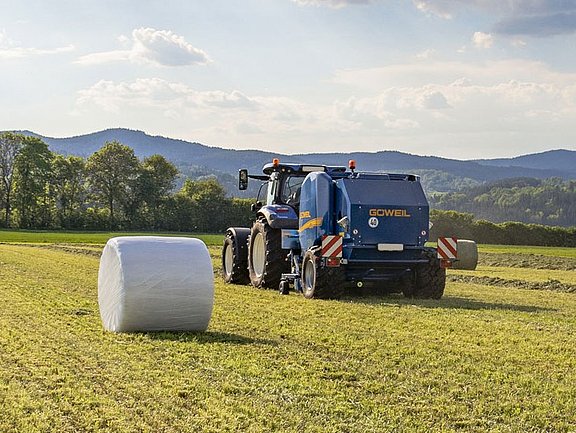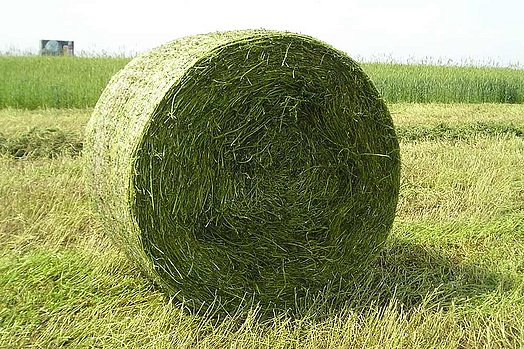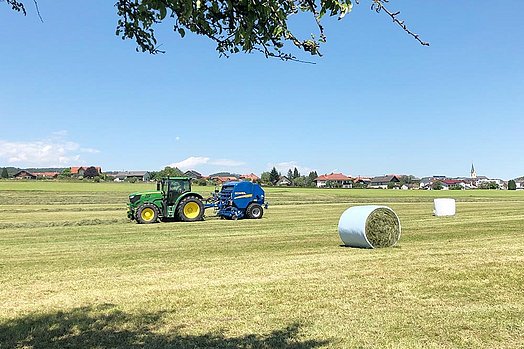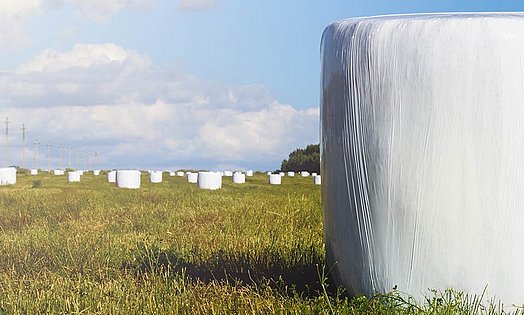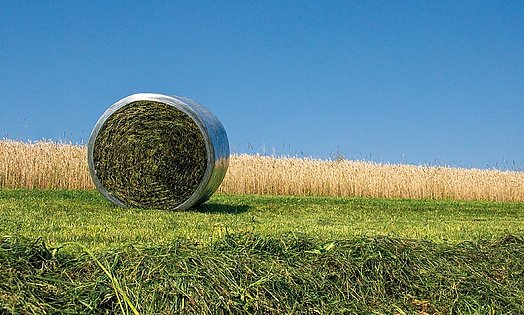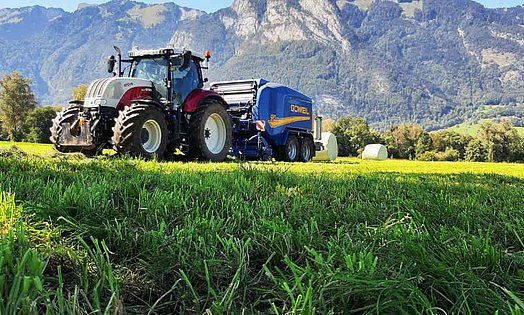Round bale silage or bunker silo?
Ideal bale density delivers high quality
The tried-and-true bunker silo or the more advanced round bales? A question that requires more than a simple answer. An argument that is often brought forward against bale silage is higher cost. The considerations herein are supposed to show if this is really true at the end of the day. Our intention behind this article was to shed some light on the situation.
General factors that contribute to silage of high quality
Quality of the crop material: Early cuts are generally of greater quality than later cuts.
Cutting height: Avoid contamination with soil from cutting too low.
Turning and swathing: Uniform turning and the right way of gathering the swaths are pivotal to quality.
Compression: The objective is to minimize the amount of oxygen in the material in order to promote lactic acid fermentation.
Film: high quality in terms of stretchability, resistance to perforation, and oxygen permeability. Learn more about this topic in our article FAQs Agricultural Stretch Film
Storage conditions: Either in a solid container as a whole or as bales deposited on their front end (where the packaging is the strongest) and with a spacing between the round bales of 5-10 cm. In our blog we have compiled a list of tips on the best way to store the bales
The methods at a glance
The first three general aspects must be factored in for both methods alike. You will already lay the foundation for great quality by taking these aspects to heart.
Bunker Silo:
The bunker silo requires a tightly coordinated sequence of steps from swathing and chopping to transporting and rolling. The procedural chain calls for employees and equipment capable of ensuring a seamless work flow. A permanent location, generally composed of a concrete slab encased by side walls, is used for silage making. Compressing the material requires a great deal of space for driving in and out. The risk of contamination from the machines used is high. Feed-out on a weekly basis is necessary to prevent the forage from fermenting again/developing mold. Equally important is the aspect of covering with film without the use of machinery, i.e. by hand. From a practical standpoint, this requires a great deal of physical strength and know-how in order to prevent errors and ultimately avoid endangering fermentation and preservation.
Round Bale Silage:
Organizing the work involved with a round baler is entirely different. The depositing options are flexible and can be changed up every year. Baler-wrapper combinations such as the G-1 F125 Kombi or the LT-Master make it possible to complete the work on site and haul away the finished bales afterwards. This affords the farmer a complete and self-contained process and allows them to remove the bales at a time of their choosing. Key aspects to consider with round bales are the portion of residual air, shape retention and also storage. This means: The outer layer of the bale must be rather tight to keep moisture from penetrating. The core, on the other hand, should allow for some additional drying - especially if the material is slightly moist hay. If the degree of compression varies widely, the bale may deform and lose its stability during storage. Bales are stored best on their front end where the film offers the greatest amount of strength.
Why is bale density such a key factor?
To achieve good, uniform and stable quality of the forage, proper compression is vital for the silage. Unless providing for sufficient compression, you will suffer losses or even complete spoilage. The preservation effect brought about by lactic acid fermentation will only be created in the absence of air.
What does it take to attain the perfect degree of compression?
Proper compression in the bunker silo requires at least three passes. Also needed is a tire pressure of 2-3.5 bar plus a certain layer thickness. The passes should not be made at too quick a pace. Compression must commence right away. The point at which the ideal compression is reached should not be exceeded. It is essential to provide for continuous compression by using a roller during ensilage. Factors that are equally important in this regard is the weight of the vehicle and the duration of the exerted pressure. The tread of the tires should not be too wide, and the inner tire pressure should be high.
When making round bale silage, you use a baler or baler-wrapper combination to complete the entire process in a single work step. Sophisticated technology makes it a cinch to produce optimum results.
What are the specific advantages of each method?
ROUND BALE SILAGE:
The highly developed technology helps the farmer reduce the number of workers needed
Greater flexibility
Effective and immediate compression of the forage directly on site
Rapid exclusion of air in the baler-wrapper combination
There are no losses in silage
There is no risk of the material reheating
Savings in silage space
Good transport option
Option to accommodate different harvesting times and subsections
In years where forage is scarce, round bales can easily be sold to colleagues without the need to open a large silo
Less ingress of dirt
BUNKER SILO:
A cooperation across multi-farms will wield tremendous clout
Effortless ensilage of multiple cuts of grassland and field forage
The selection of forage available in the silo is exceptionally wide for various cuts
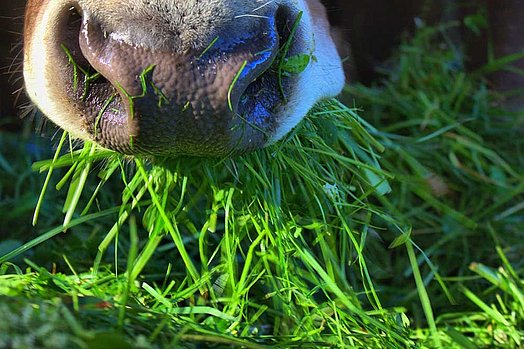
Feeding
Another matter is the feeding / removal of the silage. Here as well it makes sense to compare both methods. The risk of reheating is just as vital an aspect to account for as the formation of mold following removal. While irrelevant to round bale silage, these aspects may become an issue in the bunker silo in case of poor compression or cover. They have a negative impact on food intake as they are detrimental to the quality of the forage. This may endanger the health of the animals. All told, these harmful factors may ultimately also result in reduced yields in milk / meat.
Feed-out speed as a preventative measure: The official recommendation for bunker silos is 1m per week in the winter and 2-3m per week in the summer. This translates to the loss of great quantities of food. This loss factor is of no relevance to bale silage. The forage is always fresh.
It is possible during baling to make allowances for a bale size that has been tailored to the farming operation. Both systems are suitable for feeding in line with demand. This is made possible by ensiling different cuts in the bunker silo and by forming round bales with different degrees of compression and bale sizes.
Overview - the advantages of silo bales compared to those of the bunker silo
(under optimal conditions)
+ = better in comparison - = worse in comparison
Topic | Bunker Silo | Round Bales |
|---|---|---|
Akh (man-hours) required for the method | - | + |
Tractors required for the method | - | + |
Reheating, mold formation and forage quality Reheating and mold formation, resulting in poorer forage quality, are more likely to occur in the bunker silo. | - | + |
Compression in terms of time/quality Compression in round bale silage = less time required. The desired quality is attained in a shorter period of time. | - | + |
Space required for storage | - | + |
Harvesting small areas | - | + |
Cuts with small quantities | - | + |
Cost of the overall process | - | + |
Sale of the finished (bale) silage | - | + |
Process chain overall | - | + |
Feeding in line with demand The horizontal silo offers an advantage in that it allows for feeding different cuts at the same time. | -/+ | -/+ |
Weather risk during the harvest | - | + |
Snow removal in the winter | - | + |
Building investments | - | + |
Investments in machinery | + | - |
Multiple cuts of grassland and field forage at the same time | + | - |
Safety Every year witnesses many accidents during the setup of and the work on the horizontal silo. | - | + |
Costs:
A comparison of procedures conducted by the Agroscope Center of Excellence and involving 190m3 of silage quantity, (corresponds to 14 ha of grass silage / 3 ha of maize silage), revealed that bale silage ultimately delivered results that were significantly better. This is largely due to the savings in investment. The costs incurred by investing in the horizontal silo (option 1) are twice as high as those for round bales (option 2). The same applies to the cost associated with the storage options. Here as well the cost associated with the horizontal silo is considerably higher. The work flows from mowing to storing the material require approx. 50 Akh for option 1 and merely approx. 40 Akh for version 2.
However, an exact calculation of the cost can only be prepared specifically for each individual farming operation.
Conclusion
The general findings clearly show: those who want to enjoy great flexibility, a low amount of work, and good and fresh quality will find silage bales composed of grass or other materials to be indispensable. The pros distinctly outweigh the cons. While seemingly higher initially, the costs involved are offset by the baler option thanks to savings in Akh (man-hours), the elimination of losses linked to feed-out in the bunker silo, and the reduction of necessary storage space. All the same, it is never possible to make blanket statements in agriculture: finding the right solution always hinges on considerations about and examinations of the specific conditions at hand. The technology packed into the baler-wrapper combination used to produce bale silage has become so sophisticated that work is now a joy and marked by savings in time and cost thanks to a reduced need for man-hours.
Our round baler, baler-wrapper combinations and round bale wrappers are the ideal helpers for anyone who wishes to produce high-quality silage.
